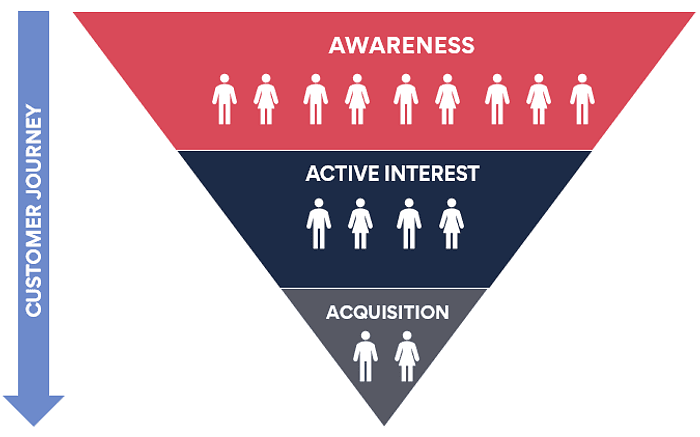With much of the world living with some level of pandemic-related restrictions over the past few months, societies have been forced to adapt. But perhaps what makes the coronavirus pandemic unique is not only have our physical lives changed, but our online ones as well.
While it is clear that technology usage trends will continue to evolve, the severity of the social distancing restrictions has already forced many to adopt new technologies (contactless payment systems), platforms (Zoom) and habits (face masks).
At the same time, businesses are under increasing pressure to minimise their marketing spend and maximise its return. With increasing numbers of individuals and organisations publishing a greater volume of content, more than ever companies are competing for attention in a saturated market.
All of this means that it is now imperative to reassess your customer journey map, so you can tailor your publishing approach to make sure that not only are your efforts read, but they also have the desired influence and impact.
Which method is best?
The customer journey is an important building block of all marketing strategies and documents the path customers (or a customer segment) take from the first step of their journey (awareness) through to making a purchase (conversion).

In essence, the customer journey identifies what drives a customer to develop a need for your product or service and what influences their decision to consider your offering and finally make a purchase. Not only does the journey map the factors that influence buying decisions, but also how and where these decisions are made. For example, online, offline or a combination of both.
However, accurately mapping your customers’ journey is no easy task. There are multiple approaches, each with a distinct set of pros and cons.
1. Traditional
- Customer Advisory Boards: A useful and insightful tactic for B2B organisations, however, risks the possibility of a handful of voices drowning out the rest of the customer base.
- Feedback surveys, forms, and calls: Collection of customer feedback, gathered either in person, or through online/print forms. Can be costly if a large user base is required.
One major drawback of this method is opinion bias, whether from internal stakeholders or your customers. Customers might be inclined to sugar-coat their feedback and to avoid any awkward conversations.
2. Data-Driven
Using marketing and research digital tools to uncover different datapoints to construct the customer journey. These include:
- SEO: What keywords or queries are my customers using to look for my product? Are they looking for specific uses for my product? AnswerThePublic does a great job in visualising search queries in all their variations and use cases.
- Market Research Platforms: Different platforms have different methodologies. Some rely on digitised customer surveys, others rely on social media profiles and data-scraping. YouTube’s Find My Audience tool, and NetLine’s Audience Explorer are great starting points to understanding how your customers interact online. For the more advanced users, Google Analytics’ behaviour flow and multi-channel funnels reports are packed with insights.
- Social Listening: Harnessing the power of social media to extract insights from conversations to understand how your audience perceives your brand, products, and to identify their pain points. Twitter’s advanced search is social listening in its simplest form, allowing you to search for tweets based on keywords, phrases or hashtags.
Depending on your industry and customer base, getting accurate and representative data, based on a sizeable dataset can be costly or problematic. Which is where the third approach comes in:
3. Combination
The best of both worlds, combining the power of qualitative and quantitative data to highlight correlations and shared themes and observations. For example, if during a focus group your customers express their likelihood to engage with content on LinkedIn over Twitter. A quick analysis of your Google Analytics social report can help support that claim.
Once you have the information you can create a map of your target customer. Below, is a simplified example of a customer journey. It tracks John, a working professional in Hong Kong, and his frustration with his internet service provider, starting with his stimulus, actions taken and marketing touchpoints.

The customer journey in action
Once the hard part is done, your job as a marketer is to build your strategy around this journey. This includes producing content that is tailored to customer needs — in formats they find appealing and published on the channels they use — throughout every step of the journey.
For example, if customers use search engines to discover and research products like yours then it makes sense to develop a keyword strategy and invest in a paid search campaign that aims to increase your top of the funnel base and increases brand awareness.
By using a journey map to target customers in this way you can ensure you content assets address your customers’ frustrations (in John’s case, a stable and reliable connection), while also reinforcing your capabilities in the form of short-videos, factsheets and guides.
While (for now) there is no method or service that can perfectly capture every step in a customer journey, new and more sophisticated tools are coming online all the time. For example, start-up SparkToro recently launched a market intelligence platform hoping to answer the million-dollar question of what exactly customers read, watch and listen to and follow based on millions of crawled profiles taking into account job, geography or topical interest.
COVID-19 has been a catalyst for unprecedented change, transforming the customer experience in unexpected ways. However, as the influence of technology on audiences continues to increase, and alters customer behaviour in response, mapping the customer journey will be become a more critical and frequently used tool for marketers.
World-class communications strategy and execution
Contact us to get started